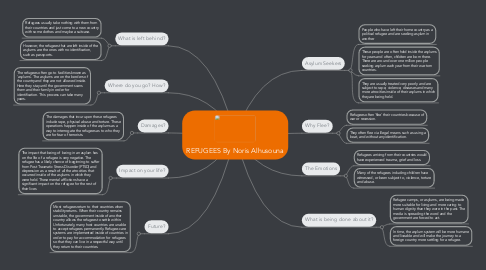REFUGEES By Noris Alhusouna
by Noris Adgdgs

1. What is left behind?
1.1. Refugees usually take nothing with them from their countries and just come to a new country with some clothes and maybe a suitcase.
1.2. However, the refugees that are left inside of the asylums are the ones with no identification, such as passports.
2. Where do you go? How?
2.1. The refugees often go to facilities known as 'asylums'. The asylums are on the borders of the country and they are not allowed inside. Here they stay until the government scans them and their family in order for identification. This process can take many years.
3. Damages?
3.1. The damages that incur upon these refugees include rape, physical abuse and torture. These operations happen inside of the asylums as a way to interrogate the refugees as to who they are for fear of terrorists.
4. Impact on your life?
4.1. The impact that being of being in an asylum has on the life of a refugee is very negative. The refugee has a likely chance of beginning to suffer from Post Traumatic Stress Disorder (PTSD) and depression as a result of all the atrocities that occurred inside of the asylums in which they were held. These mental afflictions have a significant impact on the refugee for the rest of their lives
5. Future?
5.1. Most refugees return to their countries when stability returns. When their country remains unstable, the government inside of another country allows the refugees to settle within. Unfortunately, many host countries are unable to accept refugees permanently. Refugee-care systems are implemented inside of countries in order to pay for accommodation for refugees so that they can live in a respectful way until they return to their countries.
6. Asylum Seekers
6.1. People who have left their home country as a political refugee and are seeking asylum in another.
6.2. These people are often held inside the asylums for years and often, children are born there. There are around over one million people seeking asylum each year from their war-torn countries.
6.3. They are usually treated very poorly and are subject to rape, violence, diseases and many more atrocities inside of their asylums in which they are being held.
7. Why Flee?
7.1. Refugees often 'flee' their countries because of war or recession.
7.2. They often flee via illegal means such as using a boat, and without any identification.
8. The Emotions
8.1. Refugees arriving from their countries would have experienced trauma, grief and loss.
8.2. Many of the refugees including children have witnessed, or been subject to, violence, torture and abuse.
9. What is being done about it?
9.1. Refugee camps, or asylums, are being made more suitable for living and more caring to human dignity than they were in the past. The media is spreading the word and the government are forced to act.
9.2. In time, the asylum system will be more humane and liveable and will make the journey to a foreign country more settling for a refugee.


